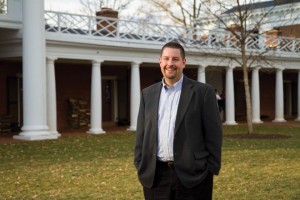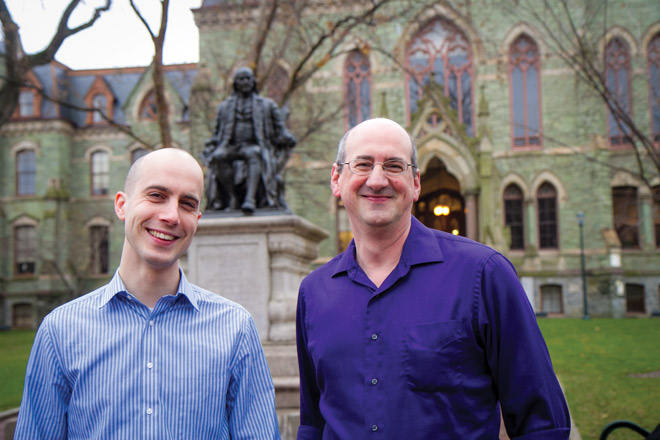As a UNIX systems engineer at Virginia Tech, Josh Akers ’07 is charged with “provisioning” a few dozen “enterprise systems” at university, while also “administrating VMware infrastructure” and supporting operation of “Advanced Research Computing clusters.”
“Anyone in the field would know what I’m talking about,” said Akers, who majored in computer science at EMU.
But yes, people not in the field, he acknowledges, are often confused about what all this actually means – and increasingly so as computer systems grow ever more complex.
“Oftentimes they don’t know how important the job is until I get that 3 a.m. call,” he says. “I’m providing critical services, and they have to be running for our tens of thousands of faculty, staff and students to do what they need to be doing.”
He likens this sort of IT role, at or near the front lines of keeping the digital world humming along, to that of a referee: invisible when things are going well, in the hot seat when things suddenly aren’t. It’s not a complaint, it’s just the way things are. Akers, about halfway done with a master’s degree in information technology from Virginia Tech, loves the challenge of the work.
“A lot of people, when they graduate, don’t find a job that they like, or one in their field,” he said. “I’m blessed to have found both of those.”
Derek Buchanan ’97 is another computer-problem first responder, as a PC technician at Mary Baldwin College in Staunton, Virginia. From the main help desk, Buchanan troubleshoots for faculty, staff and students. Forgotten passwords are their biggest bugaboo.
The job requires patience and the ability to handle people with different personalities and vastly different computer aptitudes. Some people top out at printing things and browsing the web, while others can pretty much fix any problem except in cases of major catastrophe. It generally breaks down along age-related lines. The younger the person, the more technologically proficient they’re likely to be.
The rapid pace of technological change that explains the generally age-correlated abilities of computer users on college campuses has all sorts of other implications for those colleges’ IT staffs.

“One of the big things for us is that students are coming with more and more devices,” said John Thomas ’89, chief information officer at Florida Southern College in Lakeland, Florida (he calls it the BYOD, or bring-your-own-device phenomenon).
Based on wireless network usage, he estimates the average number of wireless-connected devices carried by students at Florida Southern at just below three. Figuring out how to accommodate and capitalize on that reality are some of the big-picture tasks that occupy Thomas’s time – things like enabling students to connect their tablets to classroom projectors, or rolling out a mobile version of an online class registration system.
In 2000, when Thomas began his current role, there wasn’t wireless Internet access on campus at all. He’s since overseen installation of about 650 wireless access points, at a college with fewer than 3,000 students.
An interesting wrinkle to that story stems from the fact that the college is home to the world’s largest collection of Frank Lloyd Wright buildings. That means Thomas’s crews can’t just install a “network drop” any old most-convenient place. Rather, everything happens in consultation with architects who keep an eye out for the integrity of the buildings’ original design.
Wait a sec. Network drop? That’s the word for a wall socket that an Ethernet cable plugs into, and that’s exactly the kind of IT word that passes the non-IT world entirely by (a collection of others collected during interviews for this article: “central authentication system,” “portal,” and “migrating”). As one moves higher within a university’s IT organization, translating this sort of technobabble to the technoignorant becomes a more and more important skill.
“It is extremely difficult to use acronyms and concepts that people aren’t familiar with … We try to steer clear of it. We try to protect people from the worst of the details,” says Leslie Geary, class of ’90, a technical project manager with the University of California, Santa Cruz.
One of her roles is managing teams of up to a dozen people working on IT projects such as the recent rollout of an “enterprise web content management system” – an application that makes it easy for someone with basic computer skills to create and maintain their own websites – for the university’s administrative departments. Next up: a similar system for faculty and graduate students.
After transferring from EMU, Geary earned undergraduate degrees in philosophy and biochemistry at Santa Cruz. Computers were something she fell into by chance while later working in financial aid. As a manager in the IT department, responsible for ensuring “clients” – IT folks’ term for IT users they’re helping – are getting their needs met, she needs to understand the IT stuff, but doesn’t have to live and breathe its finest details.
“I’m not a programmer. I don’t know anything about networking. I do have some technical background, but for the most part, what’s important are the soft skills, the people skills,” she said. “People are just happy to have somebody talking IT in a non-technical way to them.”
As director of infrastructure support services and administration at the University of Virginia, Tracy Smith ’94, also bridges the divide between the worlds of IT workers and the people who depend on them.
“I’m a translator,” he said. “I help to translate technology into terms that anybody can understand. We also do a lot of listening.”
With several dozen people reporting to him, Smith oversees all IT troubleshooting at the university, from single-user glitches to massive, system-wide failures. He rarely gets involved in the technical details himself – nor does he feel he would be particularly adept at this.
“I wouldn’t make a good engineer, but I also wouldn’t be able to be something that requires a lot of right-brained power,” said Smith, who has found a foot-in-both-worlds niche he loves, helping technology at the university meet its users’ needs.
(Thomas and Smith both point out that good communication has to happen both ways; it can be very frustrating for help desk staff, for example, when they don’t get the clear, precise descriptions of problems necessary to solve them.)
In Philadelphia, Douglas Brunk ’86 is a software development director for Penn Medicine Academic Computing Service (the IT department for the University of Pennsylvania’s Perelman School of Medicine). He oversees development of software for things as varied as medical student admissions tracking, management of test tubes in stockrooms, and tracking clinical research ongoing at the university.
“I enjoy bending computers to my will,” says Brunk, who studied education at EMU. “[But] oddly enough, working with people is the part I enjoy most.”
Take the clinical research. Healthcare workers collect huge amounts of data, primarily in ways designed to serve the goal of treating individual patients. Sometimes those protocols make it very difficult to use that data for another purpose, like in research examining the treatment of thousands of patients. Software solutions can and do help with that, but cooperation between the various groups of people involved is also critical. Clinical researchers might need to convince other medical colleagues to adopt new record-keeping procedures to advance the long-term goal of better treatments for individual patients.
“Technology can help with a problem, but it will rarely solve the whole problem,” says David Brubaker ’03, senior IT project leader for the Wharton School of the University of Pennsylvania.
Whole-problem solutions require effort from people using that technology, which is why Brubaker spends very little of his time in front of a computer. He’s out and about, meeting with users, trying to figure out how the technology available to him and his team can best help the Wharton School accomplish its goals. (His responsibilities include, among others, online services offered to alumni, the IT budget, and technology that supports the school’s large alumni events that are held all over the world.)
This all relates directly to a broader point raised by many of the alumni interviewed for this article. Whether someone at a university is one of those technical folks who keeps things running behind the scenes, or an end user who doesn’t spare a thought for those technical folks until they can’t check their email, or a go-between who speaks the languages of both, they’re all playing part in the same broader university mission.
“Everything that we do ultimately is to help people grow, mature, learn and go out in society and be more productive,” says Kevin Strite ’95, project manager for the University of Notre Dame’s Office of Information Technology.
He oversees parts of various IT projects around campus, focused on lots of day-to-day details – things like estimating costs for classroom projectors in the university’s recently opened study-abroad facility in Rome, Italy. But in the sense that these seemingly mundane details – combined with the daily details of life at the help desk and in systems engineering and in software development and a thousand other places – support higher education’s larger goals of education and understanding and collective betterment, et cetera…. Yes, it all feels very worthwhile.
